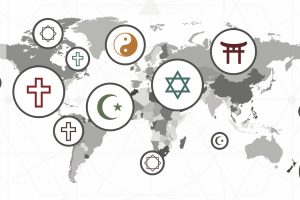Exclusive: Behind the scenes at Oxford University’s Ashmolean Museum

Ashmolean Museum, University of Oxford
On October 18th 2017, The Review of Religions were invited to a press preview of the Ashmolean Museum’s new exhibition entitled ‘Imagining the Divine: A journey through the art of religions from India to Ireland’. The BBC, various newspapers and magazines as well as foreign media were present for the exclusive guided tour by the exhibition curators in Oxford, UK.
The exhibition was born out of the Empires of Faith research project, a joint collaboration between Oxford University and the British Museum, with funding from the Leverhulme Trust. Three curators accompanied the delegation on the tour:
Professor Jas Elsner: A professor in Classical Art at Oxford University, holding previous prestigious positions in France, Germany and the USA.
Dr Stefanie Lenk: A DPhil candidate at Oxford University in Art History specialising in pre-Christian imagery.
Dr Robert Bracey: A numismatics (coins) specialist and curator at the British Museum responsible for south and central Asian collections.
________________________
‘For a thousand years, Islam tolerated the [Bamiyan Buddhas]. What happened is a one-off. Unfortunately, it’s a very destructive one-off.’
It appeared somewhat of a tangent, but Professor Jas Elsner was making a critical point. In March 2001, the Taliban destroyed two monumental statues of Buddhaas in the Hazarajat region of Afghanistan. The statues had stood for almost 1500 years, each over 100 feet tall and carefully carved into sandstone cliffs, before the Taliban government ordered their destruction (incidentally, by dynamite).
‘To associate the entire history of Islam with that act is as absurd as the act of destroying it’

Carl Montgomery | Wikimedia Commons | Released under CC BY-SA 3.0
Elsner’s reminder was timely, given the current context of the destruction of religious iconography in the Islamic world. Thousands of years and hundreds of Muslim rulers came and passed, yet the Bamiyan Buddhas, along with countless statues and iconography of various religions, remained unmolested and survived, only for exceptionally rare acts of demolition to remove them entirely. Unfortunately, it is such exceptional acts that occupy historical memories, rather than the extensive periods of preservation which preceded them.
The world of religious iconography is a complex one. Islam’s position is clear. Images and objects used to depict God, or used to intercede in contact with God, are avoided. However, intolerance towards other faiths and their religious emblems is equally discouraged. In this matter, the Taliban and other such groups should look no further than the words of the founder of Islam, the Holy Prophet Muhammadsa:

Trustees of the British Museum Central
‘You will meet those who remember Almighty Allah in their houses of worship. Have no dispute with them, and give no trouble to them. In the enemy country, do not kill any women or children, or the blind, or the old. Do not pull down any tree; nor pull down any building’ (Quoted from Halbiyyah, Vol. 3)
Prayer and scripture occupy the central fabric of religious worship in Islam. Other religions, indeed even a few sects of Islam, hold religious iconography as fundamental to worship. The Ashmolean Museum’s exhibition delves into this complex discussion by showcasing incredible objects from around the world, but centring on the world’s five major religions; Hinduism, Judaism, Buddhism, Christianity and Islam. Guided by Professor Jas Elsner, Dr Stefanie Lenk (both of Oxford University) and Dr Robert Bracey (from the British Museum), the exhibition negotiates several centuries and vast geographic lands, drawing together carefully selected objects relating to religious worship.

Trustees of the British Museum
In one space, visitors are able to observe and explore the importance of iconography which has, and continues to, relate to billions across the globe. One example which stood out – admittedly, due to it being used in most of the exhibitions promotional material – was a vast set of footprints, presenting an incredible story.
‘For the first 300 years of Buddhism, people extensively make images, but they do not depict the Buddha. Only around 100 AD… people suddenly start to make images of Buddha’.
Dr Bracey focuses our attention on enormous stone feet placed on a low plinth, apparently one of only two early pieces of Buddhist art in Europe. European collectors of the 18th and 19th centuries favoured the later image of Buddhaas – one of the famed seated figure in a meditative or trance-like state, now ubiquitous in modern Buddhist culture. The assumption was that such Buddhist statues were traceable to the time of Buddhaas himself, but for the first three centuries after his demise only wheels, footprints, motifs (such as the swastika symbol, later maladapted for use by the Nazi’s) or even void spaces were used as representations.
Why was this the case? The curators say this remains debated. But it appears some instruction would have prevented early Buddhists from creating images of this sacred individual.
Continuing through the exhibition, now in the Christianity section, we are presented with the oldest image of Christas known in northern Europe, certainly the oldest in the UK. Found in Hinton St. Mary’s Church in Dorset (UK), it was part of a larger, truly astonishing mosaic floor. The Greco-Roman influences on this image are striking.
In the background, circling the image of Christ is the ‘chi-ro’ symbol, referring to the first letters of Jesus Christ’sas name in Greek. The image has preserved remarkably well, but the broader mosaic, which is somewhat damaged, included a depiction of a typical Roman pagan scene. It provides a clear reminder of how pagan myths, adopted from the Roman Empire, permeated into Christian theology and iconography.

Victoria and Albert Museum
Elsewhere in the Christianity section, iconography on display show how early images of Jesusas alternate between bearded and non-bearded, as Christians grappled with what image of Jesusas to settle on. Professor Elsner noted,
‘As Christianity develops, it takes about 400-500 years before they really determine that they’re going to have a bearded Christ.’
It was impossible not to pause at this point. The image and sanctification of Christas through visual means had appeared to become the forefront of debate, rather than his teachings. Jesusas, the man who endeavoured so valiantly to remove pagan traditions and foster a spiritual community, was instead the centre of a deliberation over his beard! That said, it is safe to assume he was bearded, given the traditions of Jewish men around 2000 years ago.
Moving into Judaism, emphasis on scripture was apparent. Known as from the People of the Book, Jewish communities experimented in numerous formats with presentations of the Torah. On display are early manuscripts from a synagogue in Cairo, including lengthy scrolls, a tradition which has persisted into modern Judaic culture. Transmission of text, and indeed movement of text, was considered critical.
A remarkable piece is a 1000 year old Karaite Book of Exodus, stunningly endowed with ornate flowers and gilded geometric borders – influenced by Islamic manuscript illumination. This Hebrew Biblical scripture is written in Arabic, with the vowels and diacritics delicately penned in red and green ink. The Karaites were a Jewish sect who often used Arabic to translate the Hebrew Bible. They broke away from conventional Judaism and regarded the Hebrew Bible as their only authority. Such manuscripts emphasise the distinction they afforded to this Holy Book.
Entering the Islamic section, a sudden lack of figurative imagery contrasts strikingly with the preceding segments. Incredibly rare and early Qur’anic leafs and manuscripts furnish the showcases, whilst perfectly proportioned Kufic Arabic script – unreadable to many at the time – decorate objects such as pottery. Literature and writing dominate this section.
‘The materiality of the written word plays an enormously central part in the very earliest spread of Islam.’

Dr Bracey stressed the above as we filtered through this segment of the exhibition. It was through the dissemination of manuscripts and leafs of the Qur’an, believed by Muslims to be the Word of God, that Islam was able to briskly spread in the century following the Prophet Muhammadsa. However, one aspect of the written word spread through a medium that is often overlooked; Islamic coinage heralded somewhat of a revolution in how coins were meant to appear. At this point, Dr Bracey – a numismatics (coins) specialist – naturally grew in excitement and enthusiasm,
‘The moment when they [the Muslims] make a new type of coin, they do something incredibly radical. Previously, coins had a picture of a ruler on one side and a religious image on the other. That had been the way coins have looked from Western Europe to Northern India for a thousand years at this point. All coins had looked like that. Here, the radical thing they [the Muslims] do is to get rid of the images and replace them with text.’
It was an incredible insight. But, the Muslims went further in this coinage revolution.
‘…then they do something even more radical. In these very first coins, they don’t mention the ruler. The coins only mention the Kalima (proclamation of faith).’
It may appear trivial but this was a fundamental shift in the way people consumed media. In antiquity, well before the printing press or other such mechanisms had developed, visual imagery was used to convey a message much like media today, and coins were perhaps the most common and widespread image available. Every individual carries currency, even today almost all currency bears the image of a monarch, ruler, or historical figure. Indeed, most Muslim countries have returned to this concept. But early Muslims, emphasising the importance of the Creator above all else, were at pains to ensure the word of God, rather than any image, remained the most prominent concept.
Professor Elsner drew interesting parallels with the modern day to this episode of the past:
‘The kinds of questions and problems that we face with modern media, with the move from the book to the tablet or iPad and how text is digitised – these are parallels with the past. The effects are as great, because these religions would not have crossed Eurasia without being in such [portable] forms.’

This historical comparison was refreshing. Indeed, the establishment of this magazine immediately came to mind. Hazrat Mirza Ghulam Ahmadas, believed by Ahmadi Muslims to be the Messiah and Mehdi of the latter days, founded The Review of Religions in 1902 with the intent to spread his teachings across the world.
Since then, past and future editions of The Review of Religions are digitised and published online, pushing the availability of such literature to millions instantly. Similarly, the Ahmadiyya Muslim Community has translated the Qur’an in over 70 languages, utilised all forms of print and digital media and continues to explore the boundaries of the coming digital age. Early Muslims equally experimented with forms of literature consumption, allowing the Word of God to reach distant lands in a very short space of time.
Hinduism remained on the tour. Vishnuism, as Dr Bracey explained, was the aspect of Hinduism the curators chose to focus on in this part of the exhibition.
‘We focused on one set of images associated with the god Vishnu. Vishnu incarnates himself in many forms that allow him to restore order and balance to the world.’
It was, again, a movement through contrasts as a dearth in iconography from the Islamic section unfolded into an explosion of imagery here. Elaborate statues of gods, often a mixture between zoomorphic and anthropomorphic, cascaded the shelves whilst images of avatars (a manifestation of a deity or released soul in bodily form on earth) were abundant. It was interesting to see how little text was visible in this section of the exhibition. Imagery, or ‘visual language’ as the curators referred to it, was the overriding focus in Vishnuism.

c. 9th century, ink on paper.
As the tour concluded, the curators were keen to emphasise the importance of influence and interaction between the religions featured. This influence is undeniable, the infiltration of Greek and Roman mythology into Christianity is one example of this. However, what is also apparent is the abrupt stoppage or movement away from using iconography for worship in the immediate years after many of the religions of this exhibition are founded.
Thus, Judaism emphasises the scripture, Buddhists do not depict Buddhaas for several hundred years, the first image of Jesusas does not surface until the 2nd century AD, and Islam shifts all emphasis from the visual to the written.
That said, the legacy of the Bamiyan Buddhas seems to linger. Whilst this exhibition presents the visitor with an opportunity to view objects collected from around the world, many places are not so fortunate – under threat by extremist groups proclaiming destruction in the name of God.
If only they realised how hundreds of Muslims leaders before them left these aspects of history unharmed, encouraged to do so by their belief. Should the Taliban, ISIS or any other such group do so much as read the book they proclaim to be their guide, they would realise that far from destroying and causing pain to non-believers, their duty is to protect them:
‘And if anyone of the idolaters ask protection of thee, grant him protection so that he may hear the word of Allah: then convey him to his place of security…’ (The Holy Qur’an 9:6)
The Imagining the Divine Exhibition is a joint project between the Ashmolean Museum and the University of Oxford’s Empires of Faith research project. It runs from 19 October 2017 – 18 February 2018, open 10am to 5pm Tuesday to Sunday, and Bank Holidays.
To find out more, visit www.ashmolean.org
Interested in learning more about the destruction of cultural heritage and Islam’s perspective on this issue? Read this article from our archives https://test-review-of-religions.pantheonsite.io/12238/islams-response-to-the-destruction-of-cultural-heritage/
………………………………………………………
About the Author: Rizwan Safir is an archaeologist specialising in the Middle East. Over the past decade, he has extensively researched and excavated across the Middle East for institutions such as the British Museum, Humboldt University Berlin, Copenhagen University and others, whilst completing a masters in archaeology from the University of Leiden. He is the Deputy Section Editor of the Ancient Religions and Archaeology Section at The Review of Religions.
………………………………………………………




Add Comment